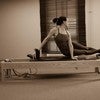Description
About This Video
Transcript
Read Full Transcript
So I put together this class as a, what I was trying to do was have a flow. So we're always moving instead of stopping, starting, stopping, starting. So the beginning is nonstop movement, reflective of reformer exercises. All right? So I wanted to go through what they are because I want you to be able to do it without stopping, right? So you don't know the order. So I have to show that to you. Okay? And basically within the order, you'll, uh, just remember the numbers three and five.
All right? So when you're in a position, you're going to do what either three times, right? Uh, or breathe three times. And then we're going to do the entire sequence five times without stopping. And at first I'll, as I'm queuing you, it's going to start slow, you know, just easy. And then I'm going to start picking up the pace so it just becomes a little quicker and quicker. Okay? So that's the first part, kind of the movement and flow part. Uh, and then we'll go into what will feel more like traditional holidays. But I like to use a little bit of muscle energy technique, uh, within the mat work.
And that just basically means a contract release thing. And I'll tell you what to do with your hands. So you're contracting or pushing and as you're doing the movement. Okay. So we'll be doing some of that work, but it's going to be pretty, some of them be familiar. Now, when I worked, um, with Nadia Corey who is, uh, one of the elders that, um, not very many people know, but her original name was Dolores. But when I met her, when she was, you know, quite old, which was in the, uh, late eighties, um, her name had changed the nausea. So, uh, and when I went to study with her, I had already been doing Palase and uh, but she was a new teacher. And so when we did the mat work, she would not let me move.
I had to hold the position of each of the mat exercises in the order and just breathe and hold, you know. So if it was like roll up, I was like this on the mat, I wasn't allowed, allowed to roll up, you know, and you know, hundreds I had to just hold, I mean I had, and then she made me do that for like a month, three times a week. But she was really particular about your alignment, your breath, you know, and being able to hold a position before you actually start switching your legs or doing arms and things like that. So I'm going to play a little bit with that. Not that are going to make you hold it forever, but we're going to do is we'll go into the positions you're familiar with, but I'm going to ask you to hold it and breathe in the position and really wants you to, uh, bring your focus really internally while you're in the position and see if you can connect your whole body. That's what I got from her. It's like all of a sudden from holding that position and just breathing and not moving, you really felt you were able to get out to both ends of your body and a little beyond. Right. So like the top of your head going a little past or the feet going a little past or the arms, you know, feeling that you have something beyond, you know, just the ends of your body. Okay.
So just try to expand into the shape and then I'm going to cue you to move. So we'll do it slow holding with that feeling, see if you can feel your whole body. And then we'll, then we'll pick up the pace and you'll do it kind of more in the normal template that you might be used to. So that would be for each of the mat exercises. And then I threw in a couple of little signature moves of mine that I like to do. Okay, so let's go over the little sequence. So first of all, the breathing okay will be the traditional [inaudible] breathing sometimes where you breathe in through your nose with your mouth closed, right? And then the exhale with your jaw relaxed. That's an EAP gentry, it's to relax your jaw. She had us doing that versus the, there's also the breathing where you purse your lips. Right? Right.
There's different, right. He was about really letting the jar relax. And the jaw has a lot of connection, you know, with attention throughout the whole body. So if you're clenching your jaw, you're most likely maybe clenching in your hips or your pelvic floor is clenching instead of being engaged. So there's a real connection between the job, you know, so, so we want to do is try to save. You're not used to it. Just try to let your job relax and do the exhales fight fogging a mirror almost. All right? Then I'm going to ask you to do some breathing.
That's all through the nose. So breathing in through the nose and out through the nose. So sometimes we'll be doing that. Okay, so that's the only breathing variation. So little review in through the nose, out through the mouth. Relax your jaw, right? So there's that one. And then breathing in and out of the nose, you see what it does to your diaphragm and you feel that when you pump. Yeah, it's really coming right this breathing, when you go nose in the jar, relaxed, you can kind of lift through the pelvic floor a little more. Huh?
So you can experience that. So if you put your attention on it, when you breathe and let your mouth jaw relax on the exhale and consciously lift the pelvic floor, right? You can feel that. But when you're sniffing in and out of the nose, it's more diaphragmatic here. So we're going back between the pelvic diaphragm and the thoracic diaphragm. Okay. So that's a little little breathing. Then I want you to, so when you're holding the position, you're actually going to be able to work with that. So that's what I mean about kind of going in and feeling and then see if you can take that and go out and feel your whole body. Okay. Alright, so let's, I'm going to show you the, the little flow sequence, which again is think of your reformer.
So everybody have reformer experience and if you don't, it's just, you know, man, matter of shape. So we're gonna experiment with breathing a little bit with him without the co contraction. The Co contraction being that pelvic floor lift and that transfers to dominance left. So we're going to do both without and with. So what we're going to deal with, so if your knees are okay in this position and you can just watch for a moment cause then you'll have to, you know, figure it out some already taking this off here. Okay? So what I want you to do is you get down into this position and you're going to wiggle like this. You see if you can do it, get your ribs down.
They see how they're in between my thighs like that. So I want the contact of the side of your ribs with the [inaudible]. And if you can't get down because your hips are tight or your back's tight, it's okay. Just get as close as you can. And as you breathe, you'll notice you'll start to sink lower. All right? And you can just stack your hands like this. And what we're gonna do is you're gonna relax your belly.
Just let it hang. So don't know. Pelvic floor, no transverse abdominis, completely relaxed abdominals. And we're going to breathe in slowly through the nose and out through the mouth. Okay? Just a couple of times. And then in that position, I'm going to ask you just to engage your pelvic floor and right. And so if you're not quite sure if you're doing it or not, it's really a 10 station in the front part of your pelvic floor. It's like you have to go pee and you're holding it back. Okay?
So it's just a light little lift around your pubic bone. And in this position you'll really feel the front more versus the back of the pelvic floor. So you're just gonna engage at lightly. All right. Which is coming then co contract your transversus and then so when you breathe in, but I want you to feel, see if it's happening at this point, you should feel your ribs pressing on your thighs because they're expanding because you're got your pelvic floor and transfer is working. Is that clear? So without the transfers of pelvic floor, relax, you shouldn't feel your ribs push on your thighs. Okay? And then when I asked you to engage in and breathe in, you should feel them pushing on your thighs. Okay?
So we're just gonna practice that. So no, not right now. Just wait. I'm gonna do my little sequence. This is the Intro, okay? So we'll do this a few times until you really get connected into your breath and connect into that co contraction. And then when we finish, we're going to inhale and you're going to come up to a quadripolar position. Now on your mat, you have to be careful not to be too far in the back because we're going to move back a little bit. So then you just come to a paired position. And we're going to do some cats here, but this is how you're going to do your cats. All right?
You have to think of the whole body. So when you go into the curl, like the Halloween cat, what I want you to do is push your shins down firmly into the mat. All right? So you're going to keep them. So if I walk around and try to lift your leg, I shouldn't be able to lift your leg. And as you do that, you're going to lift the pelvic floor now and you're going to start to curl, okay? So as you go into the curl, the other thing I want you to feel, it's as if you want to slide your legs together like that, but you're not going to move them, all right? So there what? You're as a contraction, you're lifting, the abdominals are working and the abductors are pulling up into the pelvic floor and actually lifting your pelvis more towards the ceiling so you're very active in your legs, okay? So that's when you curl. So you're pushing the shins, drawing the legs in, curling, flexing. Ideally the lower back as much as you can, the arms, you're going to have some pressure. Whenever you're on your arms, you're going to have pressure on this toe, on this toe, on this finger ball. And it's just like the big toe ball actually.
And this part of your wrist and here. All right? And I want you to think of your lower arm pulling in, just like your legs are pulling in, just the low arm, kind of drawing them in. And at the same time widening your shoulders. It's just, it's, it's a very active thing. So I don't know if you can see how it engages my, uh, upper back and my arms and my shoulders. So as I'm curling back, I'm thinking with across my arms here and in through the lower arm.
So I'm trying, I'm going for a whole body engagement with that. So that's the curl part of your cat and the cat would be so hard to do. Yeah. So here we are here and then I want you to let go of your contraction of your legs and reach your tail behind you. And at the same time bring your sternum forward. Think about your sternum, trying to move in front of your arms, but not at the cost of your tail moving behind you. So we're going to be going like this. So you're going to reach forward.
And I feel like what I'm doing with my hands now is that I'm pulling this way then, not actually moving, but just say I'm like pulling myself, but I'm contrasting with a reach back with my tail. So you feel this opening up
That's through the nose. Exhale, right? And we do it how many times? Three times, right? And on the end of the third one at right, I want you to lift your toes up and Tuck them under like this on the third one, and we're going to curl back. Now the reformer exercise here that I'm imitating without the reformer or that you're doing is Jack Rabbit or knees off, depending on what you call it. Okay, so from here, now notice the angle, my thighs, I'm pulling way back. I'm not hip over the knee. This is not an arm balance either.
Here. You're going to exhale and float your knees up and down. Really lifting from here three times on the end of the third one. You go into elephant. Okay, so third one I'm going to lift up. Now, sit bone to heal. Connection. Heels are going to come down. You keep your knees slightly bent. If you feel a little tight at first, and then you're going to curl the sit bones down. Then we're going to lift the heels. Lift the sit bones up. Up. Stretch.
Yes. Elephant curling. And I'm thinking of swinging my heels in a little bit. Hmm. And then up stretch elephant. Here's the third one. Up. Stretch. Go into elephant again, even though it's number four and you're going to curl back to your Jack Rabbit. Then you gently place your knees down and we get to slide forward.
Okay, so on our stomachs, I like your legs and parallel and wants you to feel the Asi es and the pubic bone into the mat, right? Keep your Donald's lifted and we're going to do is float the legs off. Just your thighs reaching back, lifting, and the chest is going to float. So your neck is free, your shoulder blades are coming down. I'm going to take one second to let go. Okay. And down legs, torso, legs, torso, three times. So the last one is the torso and you're gonna continue with now if you, depending on your back and how you're feeling, you can come all the way up as far as you'd like.
Then push back errand. You can leave the arms here and we get to breathe again, but not as long. Just like one breath. Okay. So I gave you the details of what I want you to think about while you're moving. But let me just go through the shapes without talking so much.
So we're going to go in here.
Finish with elephant down. Slide forward. Just have your hands comfortable here. Legs, torso, legs, torso, legs, torso, keep coming up and okay, here we go.
Comments
You need to be a subscriber to post a comment.
Please Log In or Create an Account to start your free trial.














